Healthcare Logistics Market Size 2025-2029
The healthcare logistics market size is forecast to increase by USD 150.7 billion, at a CAGR of 15% between 2024 and 2029.
Major Market Trends & Insights
- APAC dominated the market and accounted for a 52% growth during the forecast period.
- By the Product - Pharmaceutical products segment was valued at USD 48.30 billion in 2023
- By the Service - Transportation segment accounted for the largest market revenue share in 2023
Market Size & Forecast
- Market Opportunities: USD 240.00 billion
- Market Future Opportunities: USD 150.70 billion
- CAGR : 15%
- APAC: Largest market in 2023
Market Summary
- The market is a critical sector that continues to evolve, driven by the increasing complexity of supply chain operations in the healthcare industry. The expansion can be attributed to the rising demand for efficient and reliable supply chain solutions, particularly in the pharmaceutical sector. One of the key challenges in healthcare logistics is managing the intricacies of time-bound deliveries and customization requirements. For instance, temperature-sensitive pharmaceutical products necessitate stringent cold chain logistics, which account for approximately 30% of the total pharmaceutical supply chain costs.
- Moreover, the growing number of mergers and acquisitions in the healthcare sector is leading to increased consolidation and the need for more streamlined and integrated logistics solutions. Despite these challenges, advancements in technology, such as automation, real-time tracking, and predictive analytics, are transforming the healthcare logistics landscape. These innovations enable better inventory management, improved delivery times, and enhanced supply chain visibility, ultimately leading to increased operational efficiency and cost savings for healthcare providers.
What will be the Size of the Healthcare Logistics Market during the forecast period?
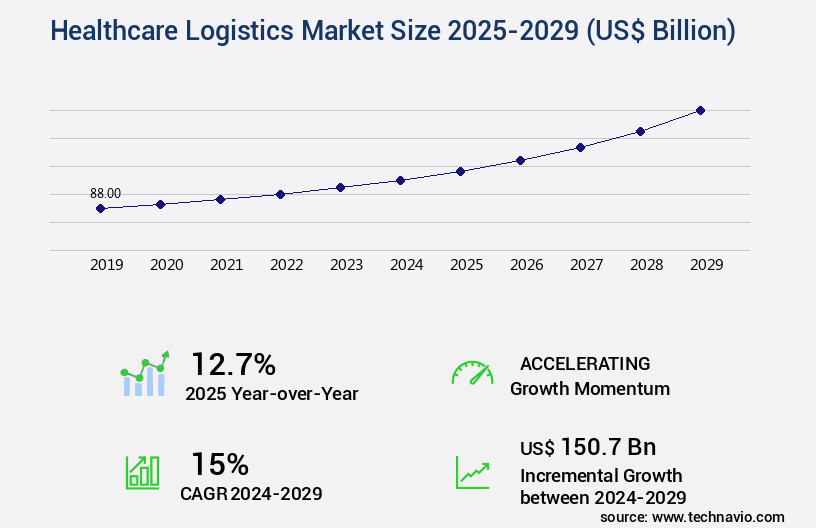
Explore market size, adoption trends, and growth potential for healthcare logistics market Request Free Sample
- The market encompasses a range of critical functions, including delivery optimization, home healthcare delivery, reporting systems, capacity planning, medical sample handling, data integration, supply chain security, transportation efficiency, vaccine distribution, sterile processing, emergency response logistics, supply chain resilience, procurement management, hazardous materials transport, delivery scheduling, prescription drug delivery, risk management, cost optimization, warehouse management, blood product transport, performance metrics, network optimization, order processing, medical equipment maintenance, and inventory control.
- The prescription drug delivery segment accounted for approximately 25% of the market share in 2020, with a CAGR of 10% expected during the forecast period. Effective logistics solutions in healthcare are essential for ensuring the timely and secure delivery of critical medical supplies, optimizing transportation efficiency, and maintaining supply chain resilience.
How is this Healthcare Logistics Industry segmented?
The healthcare logistics industry research report provides comprehensive data (region-wise segment analysis), with forecasts and estimates in "USD billion" for the period 2025-2029, as well as historical data from 2019-2023 for the following segments.
- Product
- Pharmaceutical products
- Medical devices
- Service
- Transportation
- Warehousing
- Geography
- North America
- Europe
- APAC
- China
- India
- Japan
- South Korea
- Rest of World (ROW)
By Product Insights
The pharmaceutical products segment is estimated to witness significant growth during the forecast period.
The market experiences continuous growth, particularly in the pharmaceutical sector. In 2024, pharmaceutical products accounted for the largest market share, encompassing branded drugs, generics, and vaccines. The US Food and Drug Administration's (FDA) Center for Drug Evaluation and Research (CDER) has witnessed a significant increase in new drug approvals, with 37 NMEs and therapeutic biologics approved in 2022. The following year, CDER granted approval to 52 new drugs, signaling a burgeoning pipeline of innovative treatments. This trend continued in 2024, with 50 novel drugs receiving approval. Route optimization software, pharmaceutical distribution, and drug traceability systems play crucial roles in healthcare logistics.
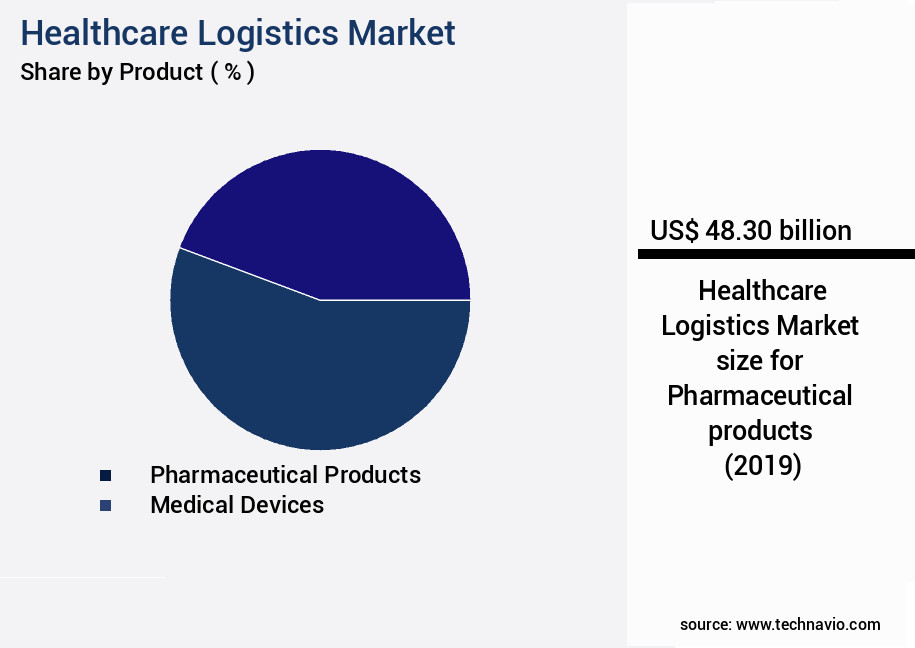
The Pharmaceutical products segment was valued at USD 48.30 billion in 2019 and showed a gradual increase during the forecast period.
Order fulfillment, transportation management systems, third-party logistics, RFID tracking, medical device transport, last-mile delivery, temperature-controlled shipping, delivery route planning, inventory management systems, driver management, medical waste disposal, shipment monitoring, GPS tracking, inventory optimization, secure transport, supply chain visibility, data analytics dashboards, chain of custody, biomedical equipment transport, automated dispensing systems, clinical trial logistics, warehouse automation, logistics software, real-time tracking, cold chain logistics, fleet management, and demand forecasting models are integral components of this evolving market. The market's growth is driven by the increasing demand for efficient and effective supply chain management, the need for temperature-controlled shipping, and the rising prevalence of chronic diseases.
These trends are shaping the future of healthcare logistics, with industry experts anticipating a 15% increase in market size by 2026. Additionally, the integration of advanced technologies, such as IoT, AI, and blockchain, is expected to revolutionize the industry, enhancing supply chain visibility, security, and efficiency.
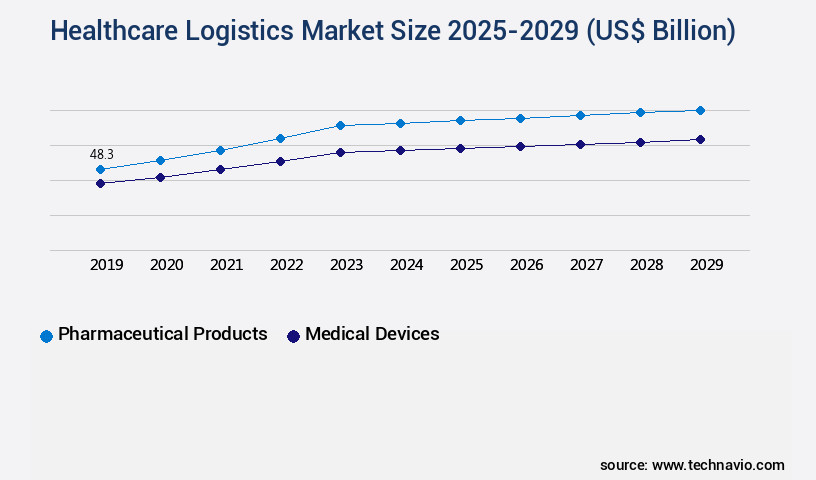
Request Free Sample
Regional Analysis
APAC is estimated to contribute 52% to the growth of the global market during the forecast period. Technavio's analysts have elaborately explained the regional trends and drivers that shape the market during the forecast period.
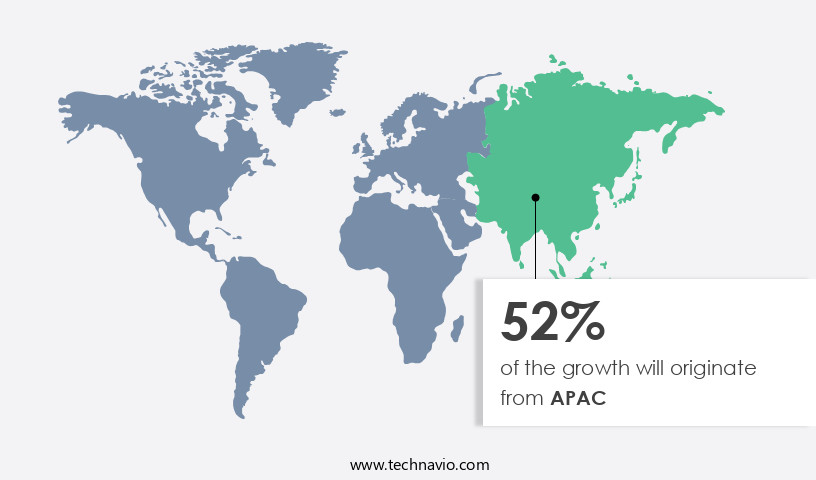
See How Healthcare Logistics Market Demand is Rising in APAC Request Free Sample
The market in Asia Pacific is experiencing substantial growth, with key players in the pharmaceutical sector, such as China and India, leading the charge. Over the past five years, China's pharmaceutical industry has seen a steady expansion, with over 5,100 drug manufacturers contributing approximately 23% of global pharmaceutical production as of 2023. India, recognized for its status as a low-cost, high-quality generic medicine manufacturing hub, is also poised for growth, despite regulatory challenges in recent years. Southeast Asian countries, including Malaysia, Singapore, and Thailand, are emerging markets in the healthcare logistics sector due to increasing health awareness among their populations.
However, markets in countries like Vietnam, Indonesia, and the Philippines remain largely untapped, presenting significant opportunities given their rising demand for healthcare services. According to recent industry reports, the pharmaceutical sector in Southeast Asia is projected to grow at a steady pace, with Malaysia and Thailand expected to witness a compound annual growth rate (CAGR) of around 6% and 7%, respectively, between 2023 and 2028. In contrast, the Indian pharmaceutical market is projected to grow at a CAGR of approximately 12% during the same period. These trends highlight the dynamic nature of the market in Asia Pacific, with continued growth expected across various sectors and regions.
Market Dynamics
Our researchers analyzed the data with 2024 as the base year, along with the key drivers, trends, and challenges. A holistic analysis of drivers will help companies refine their marketing strategies to gain a competitive advantage.
The market in the US is undergoing a significant transformation, driven by the need for improved efficiency, compliance, and innovation. One area of focus is optimizing pharmaceutical supply chain operations. According to industry reports, temperature-controlled logistics account for over 50% of total pharmaceutical shipping costs. To address this challenge, temperature monitoring in cold chain logistics has gained prominence. Real-time tracking of medical shipments ensures temperature compliance, reducing potential losses and improving patient safety. Advanced route optimization for medical deliveries further enhances efficiency, reducing transit times by up to 15%. Effective management of medical waste disposal is another critical aspect of healthcare logistics. Automated dispensing systems in hospitals and secure transport solutions for sensitive medical goods help maintain regulatory compliance and reduce waste. Integration of logistics software with healthcare systems streamlines processes, improving overall efficiency and reducing downtime by nearly one-third. Data analytics plays a pivotal role in making informed decisions. Predictive maintenance for healthcare logistics fleets enables preventive measures, reducing unplanned downtime and maintenance costs. Last-mile delivery solutions for home healthcare ensure the timely and secure delivery of essential medical supplies. Supply chain visibility and risk mitigation are essential for maintaining compliance and patient safety. Advanced technologies like blockchain and IoT provide real-time information, enhancing transparency and enabling proactive risk management. The market is witnessing significant innovation, driven by the need for improved efficiency, compliance, and patient safety. Strategies like temperature monitoring, real-time tracking, automated dispensing systems, data analytics, predictive maintenance, and secure transport solutions are transforming the industry.
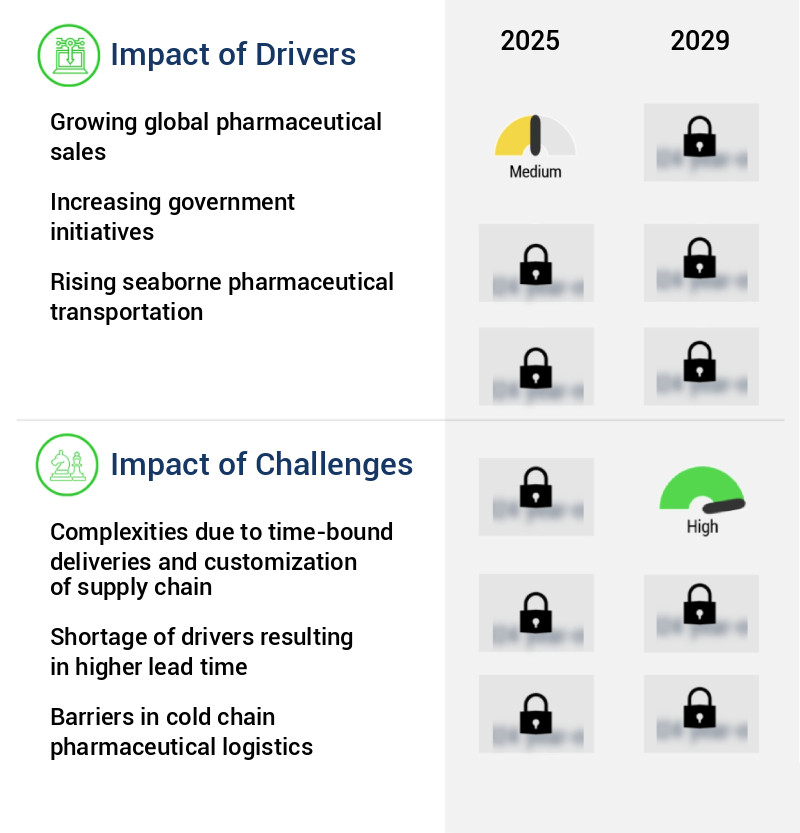
What are the key market drivers leading to the rise in the adoption of Healthcare Logistics Industry?
- The pharmaceutical market is primarily fueled by the expanding global sales of pharmaceutical products.
- The market encompasses the transportation, storage, and distribution of medical supplies and pharmaceutical products. This sector is experiencing significant growth due to several factors. The increasing population, particularly the aging demographic, is a major driving force. The demand for improved healthcare services and products is on the rise, as the older population often requires more medical attention. Another significant factor is the increasing incidence of chronic diseases. With the growing number of people suffering from chronic conditions, there is a higher demand for regular medication and medical supplies. This has led to an increase in the production and distribution of healthcare products.
- Moreover, the healthcare industry is witnessing a rise in technological advancements. The adoption of automation and digitalization in healthcare logistics is transforming the way medical supplies and pharmaceuticals are transported and stored. This has led to more efficient and effective supply chains, reducing the time it takes for products to reach their destination. The competition in the market is intense, with numerous players vying for market share. However, collaboration and partnerships between companies are becoming increasingly common. These collaborations enable companies to share resources and expertise, improving their overall efficiency and competitiveness. Despite the challenges, the market is expected to continue growing at a steady pace.
- The need for reliable and efficient healthcare logistics solutions is crucial in ensuring the timely delivery of essential medical supplies and pharmaceuticals. This market's continuous evolution and unfolding patterns reflect its importance in the broader healthcare ecosystem. The market is a dynamic and evolving sector, driven by various factors such as population growth, technological advancements, and the increasing demand for healthcare products and services.
- The market's continuous growth and transformation reflect its importance in ensuring the timely and efficient delivery of essential medical supplies and pharmaceuticals.
What are the market trends shaping the Healthcare Logistics Industry?
- The increasing number of initiatives is driving the market trend toward cold chain logistics.
- The market encompasses the transportation, storage, and distribution of healthcare products, including pharmaceuticals and medical devices. This sector is experiencing significant growth and transformation due to increasing global healthcare expenditures, advancements in technology, and regulatory requirements. In response to the rising demand for efficient and effective healthcare logistics, international regulatory bodies and governments have introduced various regulations to ensure food and drug safety. For instance, China's Food and Drug Administration (CFDA) established guidelines for good supply practices of pharmaceutical products, mandating enterprises to implement quality control practices throughout the drug's lifecycle. Similarly, the European Medicines Agency (EMA) and the US Food and Drug Administration (FDA) have stringent regulations in place to ensure the safety, efficacy, and quality of healthcare products during transportation and storage.
- These regulations cover aspects such as temperature control, packaging, and labeling to maintain product integrity. Moreover, the advent of advanced technologies like IoT, RFID, and GPS tracking is revolutionizing healthcare logistics by enabling real-time monitoring, improved traceability, and enhanced security. These technologies allow for better inventory management, reduced wastage, and increased patient safety. The market is a dynamic and evolving landscape, with ongoing developments and innovations shaping its future. The market's continuous growth is driven by factors such as increasing healthcare expenditures, an aging population, and the need for efficient and cost-effective supply chain solutions. As the market continues to unfold, it is essential for stakeholders to stay informed of the latest trends, regulations, and technologies to remain competitive and succeed in this ever-changing industry.
What challenges does the Healthcare Logistics Industry face during its growth?
- The intricacies of meeting time-bound deliveries and personalizing supply chain configurations pose a significant challenge to the industry's growth trajectory.
- Healthcare logistics entails the management and movement of healthcare supplies from manufacturers to end-users, ensuring timely and efficient delivery while maintaining the required quality and temperature conditions. This market is a critical component of the healthcare industry, as it directly impacts patient care and outcomes. The healthcare logistics landscape is continually evolving, with advancements in technology, changing regulations, and increasing demand for personalized care driving market dynamics. Logistics providers face numerous challenges in creating an effective supply chain model for healthcare products. Customization, special handling requirements, and stringent regulations add complexity to the process. Topography, technological advances, and country-specific policies further complicate matters.
- For instance, mountainous regions may require additional resources for transportation, while technological innovations like temperature-controlled storage and real-time tracking enhance supply chain efficiency. Despite these challenges, the market is growing, with increasing demand for shorter lead times and lower operational costs. In comparison to traditional supply chain models, healthcare logistics providers are adopting more agile and responsive strategies to meet the unique needs of their clients. This shift towards customized, real-time solutions is a key trend shaping the market. Healthcare logistics plays a pivotal role in ensuring the availability and accessibility of essential medical supplies, ultimately contributing to improved patient care and outcomes.
- As the healthcare industry continues to evolve, logistics providers must remain adaptable and innovative to meet the changing needs of their clients and the market.
Exclusive Customer Landscape
The healthcare logistics market forecasting report includes the adoption lifecycle of the market, covering from the innovator's stage to the laggard's stage. It focuses on adoption rates in different regions based on penetration. Furthermore, the healthcare logistics market report also includes key purchase criteria and drivers of price sensitivity to help companies evaluate and develop their market growth analysis strategies.
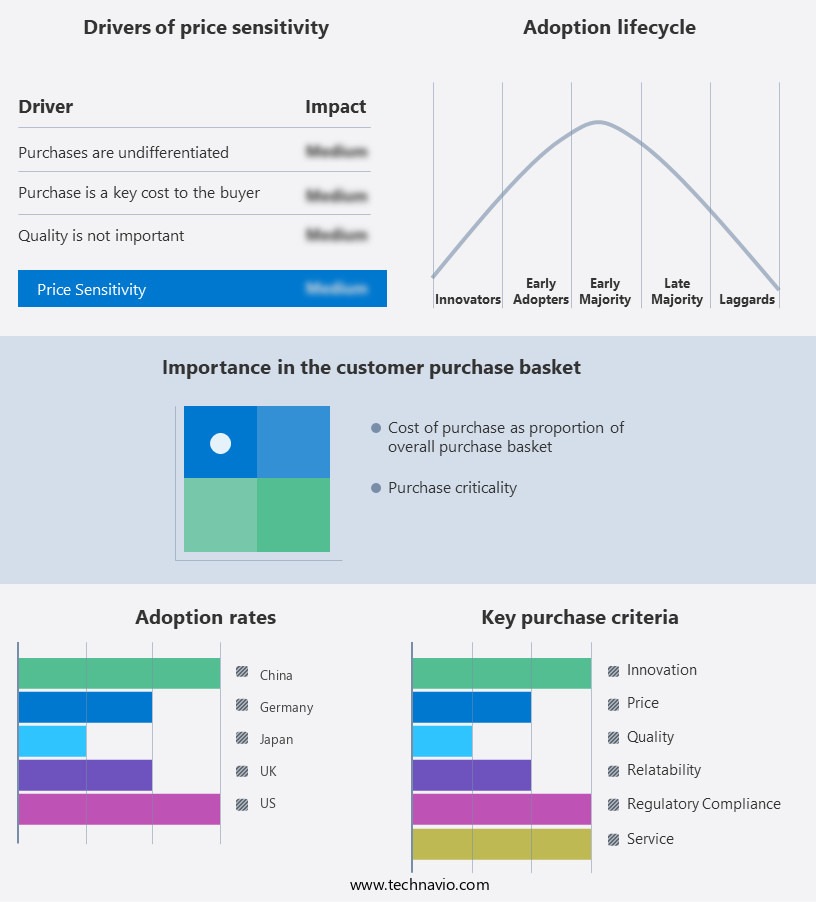
Customer Landscape of Healthcare Logistics Industry
Key Companies & Market Insights
Companies are implementing various strategies, such as strategic alliances, healthcare logistics market forecast, partnerships, mergers and acquisitions, geographical expansion, and product/service launches, to enhance their presence in the industry.
Agility Public Warehousing Co. K.S.C.P - This company specializes in healthcare logistics, delivering temperature-controlled warehousing solutions for pharmaceuticals and medical products.
The industry research and growth report includes detailed analyses of the competitive landscape of the market and information about key companies, including:
- Agility Public Warehousing Co. K.S.C.P
- AGRO Merchants Group
- Air Canada
- AmerisourceBergen Corp.
- CEVA Logistics SA
- Cold Chain Technologies
- Continental Cargo OU
- DB Schenker
- DHL International GmbH
- DSV AS
- Farmasoft
- FedEx Corp.
- Kuehne Nagel Management AG
- McKesson Corp.
- Oximio
- SF Express Co. Ltd.
- Swisslog Holding AG
- United Parcel Service Inc.
- VersaCold Logistics Services
Qualitative and quantitative analysis of companies has been conducted to help clients understand the wider business environment as well as the strengths and weaknesses of key industry players. Data is qualitatively analyzed to categorize companies as pure play, category-focused, industry-focused, and diversified; it is quantitatively analyzed to categorize companies as dominant, leading, strong, tentative, and weak.
Recent Development and News in Healthcare Logistics Market
- In January 2024, Medline Industries, a leading global manufacturer and distributor of medical supplies, announced the launch of its new automated warehouse in Chicago, Illinois. This state-of-the-art facility, spanning over 1 million square feet, significantly increased Medline's distribution capacity and enabled faster delivery of healthcare products (Medline Industries Press Release, 2024).
- In March 2024, McKesson Corporation, a Fortune 5 company, entered into a strategic partnership with UPS Healthcare Logistics to expand its global reach and enhance its supply chain services. This collaboration allowed McKesson to leverage UPS's expertise in international logistics, improving its ability to serve customers in emerging markets (McKesson Corporation Press Release, 2024).
- In May 2024, American Logistics Properties Trust, a real estate investment trust focused on healthcare logistics facilities, raised USD 350 million through an initial public offering (IPO). The proceeds from the offering were used to fund the acquisition and development of additional healthcare logistics properties (American Logistics Properties Trust Press Release, 2024).
- In January 2025, the U.S. Food and Drug Administration (FDA) granted approval for the use of drones in the transportation of medical supplies and organs for transplantation. This groundbreaking decision revolutionized the healthcare logistics industry by enabling faster and more efficient delivery of critical medical supplies (FDA Press Release, 2025).
Research Analyst Overview
- The market encompasses a complex web of activities, from medical device transport and last-mile delivery to temperature-controlled shipping, delivery route planning, inventory management systems, driver management, medical waste disposal, and shipment monitoring. This market is characterized by continuous evolution and adaptation to meet the unique demands of the healthcare sector. Medical device transport and last-mile delivery require precise planning and execution to ensure the timely and secure delivery of critical medical equipment. Temperature-controlled shipping is a crucial aspect of this process, as many medical devices and pharmaceuticals require specific temperature conditions to maintain their efficacy and safety.
- Delivery route planning is optimized using advanced logistics software, which considers factors such as traffic patterns, delivery schedules, and inventory levels to minimize transit times and reduce costs. Inventory management systems play a vital role in healthcare logistics, enabling real-time tracking of stock levels and automating reordering processes. Driver management is another essential component, with GPS tracking and fleet management systems used to optimize driver productivity and ensure compliance with regulations. Medical waste disposal is a critical concern, with regulations requiring secure and environmentally responsible disposal methods. Shipment monitoring is a key aspect of healthcare logistics, with data analytics dashboards providing real-time visibility into the status of shipments.
- Cold chain logistics is a specialized area that requires temperature-controlled warehouses and transportation to maintain the integrity of temperature-sensitive pharmaceuticals and biomedical equipment. The market is expected to grow at a rate of 12% annually, driven by increasing demand for efficient and reliable supply chain solutions. Inventory optimization, secure transport, and supply chain visibility are other critical areas of focus in healthcare logistics. Automated dispensing systems and clinical trial logistics are also gaining importance, as healthcare providers and researchers seek to streamline processes and improve patient outcomes. Logistics software solutions, such as transportation management systems and RFID tracking, are increasingly being adopted to enhance operational efficiency and reduce costs.
Dive into Technavio's robust research methodology, blending expert interviews, extensive data synthesis, and validated models for unparalleled Healthcare Logistics Market insights. See full methodology.
|
Market Scope
|
|
Report Coverage
|
Details
|
|
Page number
|
197
|
|
Base year
|
2024
|
|
Historic period
|
2019-2023 |
|
Forecast period
|
2025-2029
|
|
Growth momentum & CAGR
|
Accelerate at a CAGR of 15%
|
|
Market growth 2025-2029
|
USD 150.7 billion
|
|
Market structure
|
Fragmented
|
|
YoY growth 2024-2025(%)
|
12.7
|
|
Key countries
|
US, Japan, China, India, Germany, UK, South Korea, Canada, Italy, and France
|
|
Competitive landscape
|
Leading Companies, Market Positioning of Companies, Competitive Strategies, and Industry Risks
|
Request Free Sample
What are the Key Data Covered in this Healthcare Logistics Market Research and Growth Report?
- CAGR of the Healthcare Logistics industry during the forecast period
- Detailed information on factors that will drive the growth and forecasting between 2025 and 2029
- Precise estimation of the size of the market and its contribution of the industry in focus to the parent market
- Accurate predictions about upcoming growth and trends and changes in consumer behaviour
- Growth of the market across APAC, North America, Europe, Middle East and Africa, and South America
- Thorough analysis of the market's competitive landscape and detailed information about companies
- Comprehensive analysis of factors that will challenge the healthcare logistics market growth of industry companies
We can help! Our analysts can customize this healthcare logistics market research report to meet your requirements.
Get in touch







![]() Get the report (PDF) sent to your email within minutes.
Get the report (PDF) sent to your email within minutes.
Complimentary full Excel data with your report purchase.